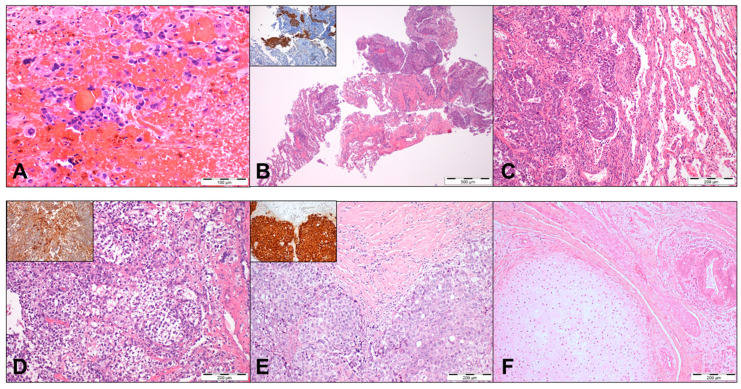Figure 1.
Illustrative histopathological examples of the infrequent tumor specimens from patients with the metastatic cisplatin-resistant disease. (A) A brain metastasis of a 35-year-old patient, presenting with stage III disease, undergoing multiple cisplatin-based courses of treatment, showing disease progression. The patient underwent excision of the brain metastasis, showing choriocarcinoma, in a bloody background. (B) A lung biopsy of a 21-year-old patient with a lung metastasis in the form of embryonal carcinoma, representing the disease progression after a first-line platinum treatment. Inset: tumor cells showed an immunoexpression of OCT3/4. (C) The previous patient was treated with multiple courses of cisplatin-based chemotherapy, but the disease progressed. He underwent salvage surgery, with a resection of lung metastases again showing a persistence of embryonal carcinoma, as illustrated in the figure, but ended up dying from disease. (D) A brain metastasis of a 25-year-old patient with stage III disease at presentation. He was treated with multiple courses of cisplatin-based chemotherapy, but the disease progressed under treatment with the emergence of a brain metastasis showing a yolk sac tumor histology. Inset: tumor cells showed a diffuse immunoexpression of alpha-fetoprotein. The patient underwent brain resection and radiotherapy to the brain but died from disease. (E,F) A post-chemotherapy retroperitoneal lymph-node dissection of a metastatic mass in a stage II patient. Dedicated sampling of the mass led to the finding of a small foci of a residual, viable nonteratoma disease, in the form of embryonal carcinoma, within a background of fibrosis and necrosis. (E) Inset: tumor cells showed an immunoexpression of OCT3/4. Within the specimen areas of the residual, mature teratoma were also present (F), with evidence of mature cartilage, smooth muscle, and intestinal epithelium. Cases were treated in our institute and retrieved from the pathology archive.

